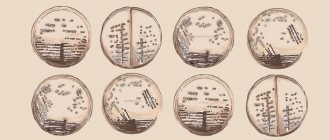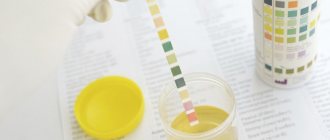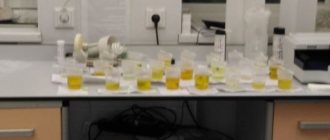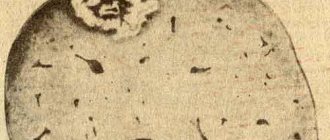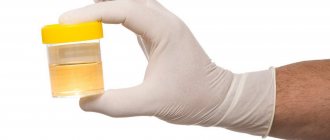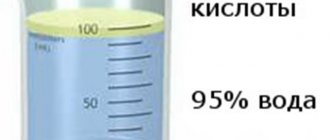Normally, a person’s urine should be straw-yellow in color and transparent, but under the influence of many factors it can become pale yellow, colorless or light, this indicator is called hypochromuria.
In the laboratory, urine values are determined by physical methods (by eye) and chemical methods (using chemical compounds and reagents).
Morning urine is more informational material for correct diagnosis. The color and turbidity of urine can be affected by the presence of abnormal amounts of protein, white blood cells, red blood cells, mucus, epithelial cells, salts and other things.
Causes of hypochromuria
Hypochromuria can be caused by natural and pathological factors.
Natural factors that discolor urine include:
- Taking medications (Furasemide, herbal decoctions and infusions).
- Age. As a rule, children’s urine is lighter; in infants, the pigments for coloring have not yet been formed)
- Amount of liquid drunk (from 2 liters). The more water enters the body, the less concentrated the color of the urine will be.
- Physical exercise.
- Ambient temperature and other climatic conditions.
- Taking diuretics (diuretics).
- Eating certain foods that have diuretic properties.
- Containing dyes or substances that can discolor urine: watermelon, cucumber, berries, juices, milk, beer, citrus fruits, bananas, grapes, parsley, grapes.
The most dangerous reasons for which urine turns light yellow include the following diseases:
- Diabetes mellitus or diabetes insipidus . Under the influence of glucose, cells are dehydrated, water goes into the bloodstream and exits through the kidneys. In this case, the patient feels constant thirst, begins to drink a lot of liquid and the urine becomes less concentrated. It also smells like sour apples. Urine in such patients in the morning and evening has the same light color, watery or pale. The same colorless color of stool may indicate the disease.
- Liver problems (cirrhosis, hepatitis) . Due to liver dysfunction and degradation of liver tissue, light flakes (fat) appear in the urine, and the urine itself becomes light yellow or whitish in color.
- Renal failure and other kidney diseases (urolithiasis, pyelonephritis, nephrosclerosis) - the smell becomes similar to acetone, a large amount of urine is released per day, it becomes colorless and soapy. Patients often feel pain in the lower back.
- Cystitis - with the disease, frequent urination disappears, the pigments of the bladder do not have time to color the urine.
The main reasons when urine turns white-yellow are:
- Hormonal imbalance in women (especially during pregnancy).
- Entry of sperm into the urethra or urinary canal in men after ejaculation. After urination, the color of the urine normalizes and becomes normal.
General urine analysis
For a qualitative study of urine, a morning portion is used. A general analysis of urine determines its transparency, color, smell, pH level, relative density, the presence of protein, leukocytes, erythrocytes, casts, epithelial cells, salts (urates, oxalates, phosphates), etc.
Transparency is determined visually. Urine is placed in a test tube or cylinder made of transparent glass and the transparency is assessed in transmitted light. Normal urine is clear. When standing for a long time, a cloud of mucus forms in it. The opacity of urine is noted if it contains impurities of salts, a large amount of mucus, cellular elements, bacteria or lipids.
The cause of cloudy urine is determined by microscopic examination of its sediment or chemical analysis.
1. If, after heating 2-3 ml of urine poured into a test tube on an alcohol lamp, the turbidity disappears, then the sample contains a large amount of urates (uraturia).
2. If after heating a portion of urine the turbidity persists, but disappears when adding a few drops of acetic acid, phosphaturia is determined.
3. If, when adding acid, the disappearance of turbidity is accompanied by hissing, it means that carbonates are present in the urine.
4. If the turbidity disappears with the addition of diluted hydrochloric acid, then the urine contains a large amount of oxalates (oxaluria).
5. If the urine becomes clear when a concentrated solution of potassium alkali is added to it, there are uric acid crystals in the urine.
6. If turbidity disappears when ether is added to 2-3 ml of urine, then the urine contains lipids (lipuria).
Color is determined by examining urine in reflected and transmitted light. Normally, a newborn's urine is almost colorless. On the 2-3rd day after birth, it acquires an amber-brown color, which is associated with the release of a large amount of urates. In young children, the color of urine is straw-yellow; in older children, its color changes from straw to amber-yellow. The normal color of urine depends on the presence of urochrome in it. In diseases of the liver, heart, hemolytic conditions, hyperthyroidosis, as well as in conditions leading to a decrease in the amount of urine (such as fever, vomiting, diarrhea, increased sweating, toxicosis, etc.), hyperchromuria is observed. Weakly colored urine (hypochromuria) is characteristic of polyuria in chronic renal failure, diabetes mellitus and diabetes insipidus, etc. The color of urine can change depending on the pathological process, the use of medications (table), as well as in response to certain foods (beets, carrots , blueberries).
Smell. Normally, urine emits a faint aromatic odor due to the content of volatile fatty acids and other substances. A stronger odor is associated with the presence of urinoid in the urine. In diabetes, acetone is present in the urine, and the smell of rotten apples is felt. When urine decomposes ammonia, it gives off an ammonia smell. The nature of the odor is influenced by the content of medicinal substances excreted in the urine.
Table
Change in urine color due to various reasons
| Urine color | Causes of urine color change |
| Colorless | Dilution, diabetes, diuretics or alcohol use |
| Milky white | Purulent diseases of the genitourinary tract, chyluria |
| Orange | Fever, increased sweating, concentrated urine |
| Reddish | Gross hematuria, hemoglobinuria |
| Dark yellow, sometimes with a greenish-brown tint | Excretion of bile pigments in the urine in parenchymal or obstructive jaundice |
| Greenish yellow | High content of pus |
| Dirty blue or green | Putrid urine due to typhus or cholera |
| Dark brown, brown-red or yellow | Hyperconcentrated urine, acute febrile states, bilirubinuria |
| Brown, brown-black or black | Bleeding in the urinary tract (with acidic urine), hemoglobinuria, porphyria, methemoglobinuria |
| Table Changes in urine color when taking medications | |
| Urine color | Medications |
| Red | Antipyrine, amidopyrine, santonin (for alkaline urine reaction) |
| Pink | Acetylsalicylic acid in large doses |
| Brown | Phenol, cresol, lysol, bear's ear, activated carbon |
| Dark brown | Sanol, naphthol |
pH reaction of urine. In a general analysis, the pH level of urine is approximately determined using litmus papers. To determine the reaction, only fresh urine is taken. When urine stands, CO2 is released from it, and the pH shifts to the alkaline side. The reaction of urine is determined by simultaneously using two types of litmus paper - blue and red. The following results are possible:
• blue litmus paper turns red, red litmus paper does not change color - an acidic reaction;
• red litmus paper turns blue, blue litmus paper does not change color - alkaline reaction;
• both types of paper do not change color - neutral reaction;
• both types of paper change color - an amphoteric reaction.
More accurately, pH can be determined using an electrometric pH meter. The acidity of urine in children increases with renal failure, diabetes, kidney tuberculosis, leukemia and other diseases leading to acidosis. A shift in the urine reaction towards alkalinity is observed during vomiting (due to the loss of chlorine ions), during the resorption of edema, plant foods and conditions leading to the development of alkalosis in the body.
Relative density. Determined by special hydrometers called urometers. The urometer scale has divisions from 1.000 to 1.060. The urometer also indicates what external ambient temperature the calibration is designed for. Usually it is 15 °C. If the temperature of the urine being tested does not coincide with the temperature for which the urometer is designed, after measuring the relative density, an amendment is made: for every 3 °C, 0.001 is added or subtracted, depending on whether the urine temperature is higher or lower than 15 °C. To determine relative density, urine is slowly poured into a narrow cylinder without causing foam to form. The cylinder is placed strictly vertically on a stable table, and the urometer is carefully immersed in the urine. When the immersion of the urometer ends, it is slightly pushed from above, but so that the part remaining above the liquid is dry. After the urometer stops oscillating, the relative density of urine is noted according to the division on the urometer scale that coincides with the lower meniscus. If there is sugar or protein in the urine, a correction must be made to obtain the final relative density value. Every percentage of sugar increases the density of urine by 0.004, and every 3% of protein increases the density of urine by 0.001. So, if the protein content in the urine exceeds 3%, an amendment is subtracted from the obtained relative density of urine based on the data given below.
Determining the relative density of urine using hydrometers is a fairly simple and fairly accurate method for practical purposes. However, in children, especially young children, it is not always possible to collect the required amount of urine so that a hydrometer can be immersed in it. In such cases, they often resort to diluting urine with distilled water 2 or 3 times, and the established indicator of the relative density of diluted urine is multiplied by the degree of dilution. Indicators of the relative density of urine are of great importance for the clinic, since they allow the doctor to judge the ability of the kidneys to concentrate and dilute urine. The relative density of urine depends on the concentration of substances dissolved in the urine. The relative density of primary urine is the same as that of plasma - 1.010, and the density of final urine can range from 1.001 to 1.040. If kidney function is impaired, concentrate and dilute urine (which is observed in nephritis and other diseases), the relative density of urine becomes close to the density of plasma or the same. The difference between the lowest and highest specific gravity, at least 10 (1010-1020), is an indicator of the normal concentrating ability of the kidneys. When the relative density of urine is below 1010, hyposthenuria is diagnosed, and within a difference of less than 10, isosthenuria is diagnosed. In newborns and children of the first year of life, physiological hypo- and isosthenuria are observed. At an older age, the relative density of the morning urine portion can reach 1.020–1.025. However, to determine the true functional capacity of the kidneys, repeated studies of the relative density of urine over 7-10 days are necessary. For this purpose, if a disease of the kidney parenchyma and a decrease in their function are suspected, special dilution and concentration tests are performed.
Microscopic examination of urine sediment. The study of urinary sediment is of great importance for the diagnosis of many diseases of the kidneys and urinary tract, allows one to judge the form and phase of the disease, and monitor the effectiveness of treatment. Elements of urinary sediment are divided into two groups: organic sediment and inorganic. The most important information for clinical practice is obtained from the examination of organic sediment. It consists of red blood cells, white blood cells, casts and epithelial cells. Inorganic precipitate can be represented in the form of crystalline or amorphous particles of phosphate salts, oxalates, urates, and uric acid. To study urinary sediment, indicative, quantitative and special methods are used. With a routine general analysis of urine using microscopy, one can only get an approximate idea of the composition and quantitative relationships of the urinary sediment. To study urinary sediment in a conventional analysis, 10-15 ml of urine is placed in a centrifuge tube and centrifuged for 5 minutes at 1000-1500 rpm. Then the supernatant is drained, and the sediment is mixed with 0.5 ml of urine, applied to a glass slide in a thin layer and examined under a microscope at medium magnification. At the same time, the nature and number of shaped elements in the field of view are noted. If they indicate single elements, it means that the element is not found in every field of view. For greater reliability, the analysis conditions are standardized, i.e. Always take the same amount of urine, centrifuge at the same number of revolutions per minute for the same time, and examine the sediment at the same magnification. Urine must be examined no later than 1 hour after excretion, since when standing, its cells are destroyed due to ammonia decomposition, which changes the pH.
Red blood cells. In the urine of a healthy person, during a routine analysis they are not detected or single elements are detected. With glomerulonephritis, tuberculosis, polycystic kidney disease, kidney tumors, hemorrhagic vasculitis, collagenosis, inflammation of the bladder and other diseases, there may be a significant amount of red blood cells in the urine. There are macro- and microhematuria. With gross hematuria, it can already be macroscopically noted that the color of the urine is changed. Due to the presence of a large number of red blood cells in the urine, it turns red, or the color of meat slop. In microhematuria, red blood cells are detected only by microscopy of the sediment. The penetration of erythrocytes into the urine during glomerulonephritis and intoxication is due to the increased permeability of glomerular capillaries and their ruptures. In inflammatory diseases of the urinary tract, stones of the pelvis, ureters, and bladder, red blood cells enter the urine from damaged mucous membranes. Red blood cells entering the urine from the glomerular capillaries, passing through the nephron tubular system, often lose hemoglobin and appear empty under the microscope ("red blood cell shadows", "leached red blood cells"), while red blood cells from the mucous membranes contain hemoglobin and are assessed as "fresh red blood cells" . When collecting urine in portions (two-glass and three-glass samples) during one urination, it is possible to find out with a high probability from which segment of the urinary system the hematuria comes. So, with hematuria from the urethra, there may be blood clots in the first portion of urine. If hematuria is caused by acute inflammation of the mucous membrane, a stone or other diseases of the bladder, more blood will be released with the last portion of urine. With hematuria associated with damage to the ureter, fibrin casts are sometimes found, the shape corresponding to the lumen of the ureter. If hematuria is due to diffuse kidney diseases, the excreted urine is uniformly colored.
Leukocytes. In the urine of a healthy person they may be single in the field of view. The detection of 5-7 leukocytes in each field of view indicates an inflammatory process in the urinary tract. However, the entry of leukocytes into the urine from the external genital organs must always be excluded, which occurs with phimosis, balanitis and balanoposthitis in men (boys) and vulvovaginitis in women (girls). Two- and three-glass tests are widely used for leukocyturia.
Cylinders. In urine they can be in the form of hyaline, granular, epithelial and waxy casts. All of them can be formed during pathological conditions in the kidneys. Casts in the urine of a healthy person are rare. They are often detected by quantitative methods of studying urinary sediment. As a rule, these are hyaline cylinders, which are protein coagulated in the lumen of the tubules. Epithelial casts indicate damage to the renal parenchyma and consist of adherent epithelial cells of the renal tubules. With a more pronounced degenerative process, granular and waxy casts appear in the kidneys. These are casts of rejected tubular epithelial cells that have undergone fatty degeneration. In addition, cylinders formed from formed elements, hemoglobin, and methemoglobin in the blood can be found in the urine sediment. The basis of such cylinders is usually protein.
Cylinders are formations similar to hyaline cylinders, consisting of crystals of ammonium urate salts, mucus, leukocytes, and bacteria. Cylinderoids are detected in the recovery phase of acute glomerulonephritis. They differ from hyaline cylinders in the heterogeneity of their structure.
Inorganic sediment. Excessive excretion of inorganic sediment elements in the urine can lead to the formation of stones in the urinary tract. Uraturia is an increased excretion of uric acid salts in the urine. It is observed in the first days of life of newborns. Due to the significant amount of urate, the urine of newborns may have a brick-red color. Large breakdown of cellular elements in newborns often leads to the formation of uric acid infarction, which resolves by the end of the first week of life. Uraturia in older children may be associated with eating large amounts of meat, and may occur with muscle fatigue or feverish conditions. Hyperuraturia can be caused by hereditary hyperuricemia, which is especially pronounced in Lesch-Nyhan syndrome. Oxalaturia is an increased excretion of calcium oxalate in the urine, which may be associated with consumption of foods rich in oxalic acid. Products of this kind include sorrel, spinach, tomatoes, green peas, beans, radishes, tea, coffee, etc. Oxalaturia can also be caused by a pathological process in the child’s body, accompanied by tissue breakdown (dystrophy, tuberculosis, diabetes, bronchiectasis, leukemia, etc. .). Oxalaturia is also known as a hereditary disease, often complicated by kidney stones and chronic pyelonephritis. With severe oxalaturia, the oxalate content in daily urine is 3-4 times or more higher than the permissible value (the norm is 8-10 mg%). Phosphaturia is an increased excretion in the urine of phosphate salts that precipitate in alkaline urine. It is observed when eating foods of plant origin (vegetables, fruits, etc.), as well as during the inflammatory process in the mucous membrane of the urinary tract, when bacterial fermentation and alkalization of urine occur. Phosphaturia can cause the formation of bladder stones.
Quantitative assessment of urinary sediment elements. Determining the number of erythrocytes, leukocytes, casts, Stern-Gamer-Malbin cells, and active leukocytes in the sediment has diagnostic and differential diagnostic significance.
Similar articles
medn.ru
Why is hypochromuria dangerous?
If all indicators in the urine test are normal, except for the presence of hypochromuria, it is necessary to stop taking medications, avoid eating foods that remove the yellow color in urine, and undergo repeated clinical tests.
Hypochromuria may also indicate dangerous pathological diseases and dysfunction of internal organs. If deviations in other urine parameters are detected, it is necessary to find out the cause and begin to treat the disease. If not treated promptly, the patient's condition may worsen and lead to death.
Opaque urine during pregnancy
A pregnant woman often experiences temporary disruptions to her body’s normal physiology. Most often this occurs in early pregnancy and is associated with toxicosis and dehydration due to frequent vomiting. At the same time, the load on the kidneys greatly increases, which often leads to some dysfunction, and this can be manifested by loss of urine clarity. In most cases, such processes normalize on their own, however, if toxicosis is particularly severe, you should undergo a course of medical therapy in a hospital - this will make life much easier for your body and your unborn child.
Unfortunately, the range of factors that can lead to loss of urine clarity is not limited to natural female physiology. Any others are possible - infectious inflammation, kidney pathologies, and even a genetic predisposition to certain diseases. In view of this, the slightest changes in the usual color and transparency of urine, especially in such a vulnerable state, should not be ignored. Women suffering from chronic forms of diseases need to be especially careful - pregnancy often leads to their exacerbation.
Diagnosis of hypochromuria
Detection of hypochromuria is carried out by clinical examination of morning urine (general analysis) and a color test. If detected, it is necessary to examine a doctor, who may additionally prescribe a repeat urine test or additional examinations and tests (biochemical tests of urine, blood, ultrasound diagnostics of the kidneys, liver, liver tests, glucose tests and others).
To diagnose diabetes mellitus, the doctor may prescribe a urine test according to Nechiporenko, a test according to Zimnitsky, an analysis of daily diuresis, and determination of glucose in daily urine.
In case of cystitis, a sample is taken for the sterility of urine and a urine test according to Nechiporenko. In case of renal failure - the Reberg-Tareev test and the Zimnitsky test.
In some cases, the doctor may additionally recommend a CT or MRI scan or contrast imaging of the kidneys.
What does clinical OAM show?
You can more fully assess the value of the analysis by reading the list of what a general urine test shows. Organoleptic indicators, the content of blood cells, microorganisms, epithelial cells and various substances of organic and inorganic origin are determined in the laboratory:
Urinalysis indicators are important due to:
- their correlations with the state of the blood;
- information content regarding the processes occurring in many internal organs;
- the ability to identify a large number of pathologies without additional research.
Deciphering a general urine test in adults allows you to confirm or refute the presence of diseases of the excretory and digestive systems, and inflammatory processes.
Can a baby have completely colorless urine?
The color of urine is a parameter that can be easily assessed visually. There are two factors that directly affect this indicator: the age and nutrition of the child. As mentioned earlier, in children in the first days of life, urine is almost colorless, and only over time it acquires a rich color.
Infants typically have very light-colored urine. When breastfeeding, it is worth considering the fact that the mother’s consumption of coloring foods during this period, such as carrots, beets and citrus fruits, can change and color the baby’s urine.
Another explanation for the presence of almost colorless, pale urine in a baby under 1 year old is excessive drinking or the presence in the diet of foods that have a diuretic effect. Among the pathologies leading to this effect are:
- diabetes mellitus and diabetes insipidus;
- nephrosclerosis;
- kidney diseases.
What to do and how to treat
To make your urine a normal color:
- Reduce the amount of liquid you drink per day.
- Check the ability of medications taken to clarify urine.
- Stop eating foods that remove the color of urine.
As a rule, hypochromuria is a harmless phenomenon and often occurs not due to pathological problems, but through physiological causes. If the violation of the indicator does not go away, it is necessary to contact a therapist or pediatrician (hypochromuria in children) and undergo a comprehensive diagnosis of the identified problem.
Preventive measures and procedures should also be carried out:
- For infections of the genitourinary system, it is necessary to increase fluid intake and do not hold back urination (do not tolerate it).
- If you have urolithiasis, drink a lot of water, reduce your intake of salt, protein foods and exclude some types of plant foods.
You should immediately consult a doctor if your urine is light in color in combination with severe symptoms:
- Pain in the abdomen, lower back.
- Constant thirst for drink.
- General poor health, fatigue.
- Evacuation of light-colored feces.
- Increased body temperature.
- Frequent urge to urinate.
- Burning and discomfort in the urethra when urinating.
- Pregnancy and breastfeeding.
- Other symptoms, as well as acute viral infections against the background of hypochromia.
What to do if men urinate frequently at night?
Have you been struggling with PROSTATITIS and POTENTITY for many years without success?
Head of the Institute: “You will be amazed at how easy it is to cure prostatitis by taking it every day...
Read more "
Frequent nighttime urination is recognized as an unnatural condition in which nighttime urination exceeds the age-appropriate norm. Polyuria is defined by the fact that an adult regularly wakes up to use the toilet more than once during the night.
The symptom occurs suddenly and is permanent. In this case, the normal discharge rate is exceeded several times, and the volume of urine emitted at night is equal to that of the day. For men who are not taking any offending medications, this condition should be cause for concern and cause a visit to a specialist.
Symptoms of night urination
Frequent urination at night in men is mainly accompanied by the following clinical symptoms:
- The urge to go to the toilet causes unpleasant sensations, which are accompanied by discomfort in the groin area.
- After a man defecates, a burning sensation occurs that lasts for some time.
- Itching in the area between the anus and the genitals begins to bother you.
- Urine has an unpleasant odor and an unnatural color.
- Blood clots or purulent impurities are observed in the discharge.
Also, frequent urination at night in men can be caused not only by the disease, but also by stones in the kidneys and urinary tract. They can help interrupt the process of urine excretion from the bladder without completely emptying it.
Very often, nocturia in men indicates the presence and progression of diabetes mellitus. Therefore, experts recommend undergoing examinations and donating blood for sugar from time to time.
Causes of polyuria
Since the symptoms together give a wide range, it becomes difficult to determine the main reasons for frequent urination at night:
- Regular urge to emit in men can be caused by the presence of infections in the canal. This inflammation is called urethritis.
- The cause of cloudy urine and the appearance of an unpleasant odor, as well as the content of purulent masses, may be the occurrence of cystitis.
- You can also suspect prostatitis in a man if, with polyuria, the discharge does not exceed a few drops, pain and burning are present.
- Frequent urination in men very often indicates joint diseases - osteochondrosis, reactive arthritis and others. If we delve into the essence of the issue, we can safely say that arthritis is not the main cause of polyuria.
- Also, another of the main reasons for frequent nighttime urges to go to the toilet is benign prostatic hyperplasia or, more simply, adenoma. In the presence of this disease, special neoplasms begin to appear in the prostate, which more closely resemble bubbles. They begin to compress the canal, causing a deterioration in urine output. The situation is much worse in the presence of prostate cancer.
- A factor that contributes to frequent urination in men is chronic renal failure (CKD). The reason is the death of kidney cells and, as a result, the proper functioning of this organ is disrupted.
- Frequent urge to urinate at night can be caused by urolithiasis. Formations in the form of small stones that are located in the kidneys and make it difficult to remove fluid. Then men have a frequent urge to go to the toilet, there is polyuria, and the urine is mixed with blood.
If a man has any metabolic disorders in the body, then they can become a source of frequent urination at night. These include diabetes mellitus and diabetes insipidus, and impaired urine acidity. Nocturia, which is caused by high blood sugar, has been studied by doctors since ancient times. Anemia is also a possible cause of polyuria.
The causes of frequent urges are disorders of the nervous system, stressful situations, and disturbances in the emotional state of men. They cause reflex actions on the walls of the bladder. Frequent urination may continue for a long time after the source of the nervous disturbance has passed. These reasons often cause urination in children and women.
Also, organic disorders (damage to the spinal cord or deterioration of the endocrine system caused by natural aging) can cause symptoms of frequent urination at night.
The inherent condition of the female body - pregnancy and menstruation - can cause a regular urge to urinate frequently. In this state, you should not worry about the woman’s health, as this is natural, but this is provided that all test parameters are within normal limits. If you begin to observe frequent urges, and your body has characteristic signs of one of the above diseases, then this is a good reason to visit a urologist.
Treatment and prevention of polyuria
A large number of reasons that contribute to frequent urination at night in men require a thorough examination of the patient in order to make a correct diagnosis. The treatment itself should be a complex. In most cases, it is aimed at restoring kidney function.
Treatment for nocturia includes:
- Switch to proper nutrition. By changing your diet, you can compensate for the loss of electrolytes in the body.
- Taking vitamins, minerals and organic supplements.
- Prescription of drugs that include calcium, potassium, sodium and other micro- and macroelements.
- In case of large fluid losses, intravenous infusion of solutions is prescribed. The functioning of the cardiovascular system must be monitored.
Preventive measures for nocturia
To prevent the occurrence of this disease, which causes discomfort, it is necessary to adhere to preventive measures, which include:
IT IS IMPORTANT TO KNOW! D. Pushkar told how to defeat prostatitis at home...
Such a pleasant treatment for prostatitis for 147 rubles...
- Performing Kegel exercises, which help strengthen the muscles of the urinary tract. These exercises must be done daily for at least two months. The number of repetitions should gradually increase.
- Improving your diet. It is necessary to limit the consumption of foods that stimulate urine production.
- Keep fluid intake under control. Don't drink a lot of water before bed.
- Timely diagnosis of the disease.
- Control and treatment of diseases that may cause frequent urination at night.
- Compliance with contraceptive measures that can protect both men and women from contracting sexually transmitted infections.
- Elimination of hypothermia.
- Strengthening the immune system, especially in the spring-autumn period, when the lack of nutrients in the body is very noticeable.
But the most important preventive measure for polyuria is to prevent neglect of the body’s condition and promptly contact a specialist.
When is it prescribed?
Understanding what a urine test for atypical cells is, you need to know that it can be prescribed not only to confirm or refute the progression of a serious disease, but also for preventive purposes, for example, if the patient comes to the clinic for a regular examination.
In most cases, the study is prescribed for the following purposes:
- Detection of cancer cells;
- Suspicion of the presence of tumors in the organs of the urinary system;
- Determination of the location of tumors;
- Monitoring a patient diagnosed with urinary tract cancer;
- If blood cells are detected in urine;
- To confirm or refute the primary diagnosis;
- If necessary, evaluate the effectiveness of the therapy;
- Routine examination of patients undergoing surgery.
It is also worth noting that it is not advisable to conduct research without the need. That is why the majority of doctors receive all the necessary information from the results of a general clinical analysis of biological fluids of the body. Cytology is indicated only in situations where there is a suspicion of oncology.
Transparency
The transparency of the provided liquid is determined visually, for which it is poured into a transparent container, and the appearance is assessed under light. Specialists examine the color of the urine and the presence of sediment.
Normal urine should be absolutely clear; if it is left to settle for a while, sediment can be isolated in the form of lipids, cell elements, mucus and bacteria. Such turbidity is determined by chemical analysis and in the field of view of a microscope.
- If the turbidity disappears when the test liquid is heated, this indicates a significant amount of urate, and a diagnosis of uraturia is made;
- If the turbidity remains when heated and the temperature rises, acetic acid is added to it and when the suspensions disappear, a diagnosis of phosphaturia is made;
- If, when adding acid, it begins to fizz, this indicates the presence of carbonates in the liquid;
- When interacting with hydrochloric acid, the turbidity disappears due to the high amount of oxalates;
- When reacting with potassium and alkali, urine becomes transparent due to the content of uric acid crystals;
- Lipuria is characterized by the transparent color of heated urine when liquid ether is added due to the content of lipids in the chemical composition.
The color of urine is a visual indicator that is examined in reflected light. When a baby is born, the urine is clear and almost colorless. After a couple of days of life, it acquires an amber-brown color, which indicates the release of a significant number of urates during the restructuring of the genitourinary system of the newborn.
In preschool children, urine is straw-yellow in color, and the older the child, the more yellow the urine becomes. The natural color of urine depends on the content of urochrome in it. Intense color indicates heart and liver diseases, hemolytic pathologies and hyperthyroidism.
With toxicosis, high fever, vomiting or diarrhea, the amount of urine decreases and hypochromuria is diagnosed. It is also observed in renal failure and diabetes mellitus. In this case, the urine is very lightly colored.
What does color say?
The color of urine is determined visually, it is examined in transmitted and reflected light. When a baby is just born, his urine is practically uncolored, but after a couple of days it becomes amber-brown. This indicates that a large amount of urate was released. At preschool age, children's urine becomes straw-yellow in color; at an older age, it can be either straw or amber-yellow.
Natural coloring depends on the presence of urochrome.
If the color is very intense, then this indicates liver and heart diseases, hyperthyroidism, and various hemolytic pathologies. Fever, toxicosis, excessive sweating, vomiting and diarrhea can lead to a significant decrease in the amount of urine. In this case, they talk about hypochromuria. This pathology is observed in diabetes mellitus, kidney failure and a number of other diseases. In this case, the liquid being tested is slightly colored.
The color of the analysis directly depends not only on pathological processes, but also on the use of certain medications or on the food that a person consumes. For example, the liquid becomes more colored after eating beets, blueberries or carrots.
If we talk about diseases that can be diagnosed by the color of urine, it looks something like this:
- colorless liquid may occur when drinking alcohol or developing diabetes;
- milky white urine occurs due to chyluria or purulent processes in the genitourinary tract;
- orange indicates fever or increased sweating during the hot season;
- red indicates hemoglobinuria or gross hematuria;
- dark, rich yellow in color, sometimes with the presence of a greenish or brown tint, indicates obstructive jaundice or excretion of bile pigments in the urine;
- if there is pus in the urine, it becomes yellow-green;
- dark yellow, dark brown or brown-red colors indicate its strong concentration, elevated temperature or bilirubinuria;
- if there is bleeding in the urinary tract, as well as with porphyria and hemoglobinuria, the urine may turn black, brown or black-brown.
As mentioned above, urine changes color when taking medications. The red color may be due to the intake of Amidopyrine, Antipyrine, Santonin; if the patient has taken Acetylsalicylic acid (especially in large quantities), then the urine may become pink. When taking Cresol and activated carbon, the urine turns brown. Dark brown urine occurs when taking Naphtol, Sanol.
Causes of changes in the color and smell of urine
The color and smell of urine do not always remain unchanged; they are influenced by many factors, both physiological and pathological. Also, the color of urine depends on age.
For example, in the first days after birth, infant urine is practically uncolored, but after 1-2 days it acquires an amber-brown color, due to the release of a large amount of urates. In preschoolers, the normal color of urine is straw-yellow, but in schoolchildren and teenagers it can vary from straw to amber-yellow.
Various pathologies can serve as a source of deviations from the norm. The table shows possible variations in the shade of urine and the reasons that caused them:
| Urine color | Cause |
| dark yellow |
|
| brown-yellow |
|
| light yellow |
|
| red, rose red or brick red |
|
| red-brown |
|
| red-brown |
|
| green |
|
| yellow-green |
|
| blue |
|
| orange |
|
| brown, dark beer color |
|
| black-brown |
|
| black, brown or black-brown |
|
| milky white |
|
| colorless |
|
The following table lists the reasons that cause unnatural odor in urine:
| Smell | Cause |
| ammonia |
|
| apple or acetone |
|
| rotten |
|
| feces |
|
| stinking |
|
| cheese or sweaty feet |
|
| mice (musty) |
|
| maple syrup |
|
| cabbage, hops |
|
| rotting fish |
|
| fish |
|
| violets |
|
| swimming pool |
|
How urine is donated for OAM
How to properly test urine in children? To evaluate the test result, urine must be tested correctly. To do this, parents should follow certain rules:
- For analysis, only morning urine is shown, which was collected at least 6 hours before the previous bladder emptying;
- before collecting urine, you should wash the child’s genitals without any detergents (this is done with warm, but not hot water);
- Urine can only be collected in a sterile container that closes tightly (a small jar is suitable for this, but if you don’t have one, you can purchase a special container at the pharmacy, which costs about 10 rubles);
- The average volume of urine should be 100-150 ml, since only one tube of urine is required for the analysis.
The collected urine must be delivered to the hospital within 2 hours. Until this time, it should be stored in a cold room.
At the same time, in the evening, the baby should not eat brightly colored vegetables and fruits, eat a lot of sweets and drink drinks with dyes, since all this can cause a change in the composition of urine. If the urine is taken after the child has emptied his bladder at night, it is better to ask to reschedule the test, since it will show incorrect indicators - for this, it must be bright and highly concentrated so that the doctor can understand if there are unacceptable substances in it, or if they are completely absent.
If the child has any deviations from the norm (interpretation and other deviations), there is no need to panic - it is recommended to take the test again, and if it again shows abnormalities in the composition of urine, it is already necessary to take specific actions aimed at improving the tests.
Why the boy’s head does not open: what to do?
Every parent of a boy sooner or later has a question about when the head of the penis should open from the flesh, and also what to do if the boy’s head does not open. Numerous observations have confirmed the fact that for each boy the opening process occurs at different times, so the time frame cannot be unambiguously determined. The main thing that is required from parents is an attentive attitude to the child’s well-being and behavior.
Only an experienced specialist will be able to clearly say whether the head should open at one time or another in the child’s life. Therefore, if anxiety and anxiety appear, it is better to visit a pediatrician or surgeon. In addition, it will not be superfluous to study special literature on the anatomical features of the structure of the penis, its development and age-related characteristics in young men.
Norm: when should it open 100%?
A man’s penis does not undergo any important modifications throughout his life. The only point is the opening of the head from the foreskin in childhood. At an early age, the foreskin, which in medicine is called the preputial sac, is fused in places to the head of the penis, having an elongated shape. It is attached to the head using synechiae - connective tissue adhesions.
The baby's head has only a small hole for urine to pass out. It is only a few millimeters. Doctors do not recommend any manipulations to cut the foreskin and frenulum for boys under 3 years of age. Otherwise, there is a risk of developing circulatory disorders, pinching of the head, or even necrosis.
There is such a thing as physiological phimosis, which is common to all boys from childhood, when the head is not able to extend beyond the flesh. From a physiological point of view, the head will release itself over time, and this process occurs in all children at different times, for some as early as a year, and for others at 5-6 years old. Physiological phimosis does not always end well; you need to regularly examine the genitals for alarming symptoms.
To understand the physiological features of the development of the genital organ in a boy, the process of opening the head and the age range, you can consult a doctor or view the following picture:
There is no need to stretch and massage the baby's head and foreskin if there are no complaints from the baby. Even if he is already 6 years old, the lack of head release is not always a cause for concern. Only a surgeon can assess how appropriate it is to intervene in physiological phimosis. To summarize, we can determine the time frame for independent release of the head - from 3-4 to 12 years.
What to do if it doesn't open?
The doctor can prescribe treatment in case of a closed head if there are alarming symptoms. Namely:
- redness in the head area;
- signs of inflammation;
- noticeable swelling;
- pain and discomfort during urination.
After a visual examination by a urologist, as well as tests, you can determine how appropriate the doctor’s intervention is. In the case of the initial stage of phimosis, the doctor may prescribe a method of conservative therapy - the use of ointments, anti-inflammatory drugs, gradual stretching of the foreskin and the use of traditional medicine. Severe forms of phimosis may require surgery.
Incorrectly performed opening of the head can lead to the development of paraphimosis, leading to blood stagnation, impaired lymphatic and venous outflow of blood, and in extreme cases, tissue necrosis. Only timely contact with a specialist will allow you to avoid surgery by eliminating the problem manually. In some cases, parents resort to circumcision, which also prevents phimosis and paraphimosis.
Recommendations from Komarovsky
The world-famous television pediatrician Komarovsky enjoys the trust of millions of parents. He advises not to resort to drastic measures if the boy’s head does not open in childhood. In his opinion, the genital organs and physiology are designed in such a way that the protection of the child’s penis occurs independently with the help of physiological phimosis.
The foreskin, as well as the smegma located underneath it, are responsible for insulating the head of the penis for a reason. Smegma has an excellent bactericidal effect, otherwise it will be enough just to regularly wash the genitals with soap. It is important to rinse the detergents out of the foreskin well so as not to irritate the delicate flesh. The doctor sees no reason to excise the foreskin if it does not cause concern to the child.
What to do if hypochromuria is detected
Hypochromuria is just a laboratory indicator. First, you need to exclude drugs and foods that can affect the color; this can happen when you drink too much or when taking diuretics. In addition to color, other physical and chemical changes in urine must also be taken into account. Sometimes faintly colored urine has a fairly simple explanation. This may be an incorrect sample collection, or the patient drank a lot of liquid the day before and thus collected very diluted urine.
However, if hypochromuria is still detected when the test is retaken, then we are talking about systemic diseases. In such cases, you should consult a therapist, and then a specialist and undergo a full examination.
Causes not related to diseases
A natural factor in the darkening of urine in a child, which does not pose a danger, is prolonged restraint during night sleep. At this time, the kidneys function and cleanse the body of waste products. Lack of urination leads to an increase in the density of biological fluid and an increase in the concentration of salts and other substances that make the color of urine more saturated. Therefore, the morning portion of urine is always darker than the subsequent portions during the day.
Dark colored urine can also be the result of dehydration after exercise or during hot weather. Insufficient fluid intake and increased sweat secretion leads to a decrease in the volume of primary urine and an increase in the level of pigments and waste products of the body, which color the biological fluid in a darker shade
Therefore, it is important to monitor your child’s drinking regime and offer water regularly.
The next reason for dark urine in a child is the consumption of certain foods. In infancy and children 2 years of age are very sensitive to the introduction of complementary foods, which is reflected in changes in the color of urine and stool. If, when discontinuing a new product, the color of urine and feces does not return to normal, you should consult a pediatrician and undergo a series of tests.
The following foods affect the color of urine:
- beef;
- some types of fish;
- bright vegetables (beets, carrots, rhubarb, tomatoes);
- legumes lead to darkening of urine;
- fruits and berries of dark color (blueberries, blackberries, currants);
- products rich in food coloring (caramel, marmalade, cakes).
Sweet carbonated drinks with dyes (cola, tarragon, lemonade) also change the color of urine. In adolescents, darkening of urine may be associated with dehydration due to drinking alcoholic beverages. After the body has recovered and food and drinks have been eliminated from the body, urine takes on its natural yellow or straw color.
Another reason why a child has dark urine is the use of medications. So yellow-orange color of urine can be a result of taking:
- vitamins;
- antibacterial drugs (Metronidazole, Rifampicin, Tetracycline);
- antimicrobial agents (nitrofuran group).
Brown urine indicates intake of:
- sorbents (Activated carbon);
- laxatives (Senadexin).
Redness of urine in young children is caused by taking antipyretic, painkillers and anti-inflammatory drugs (Nurofen, Aspirin, Paracetamol). After taking Indomethacin, your urine may take on a greenish tint. After the active components of the medications are removed (the time is indicated in the instructions), the urine returns to its natural yellow color.
If your baby's urine is completely colorless
A newborn baby produces dark-colored urine for several days after birth while the kidneys adapt to the new conditions. In infants, the absence of urine color is normal. This is due to the fact that urinary fluid contains fewer substances, i.e. has a low specific gravity. In addition, a child under one year old cannot hold urine; it is released almost immediately after entering the bladder. A 7-month-old baby no longer eats only breast milk, but also formula and complementary foods, so the urine begins to change color to straw yellow.
During puberty, hypochromuria in a urine test in a child may indicate hormonal imbalances or the development of endocrine diseases accompanied by an increase in the amount of urine excreted (diabetes insipidus, dysfunction of the thyroid gland, adrenal glands, pituitary gland).
Treatment and prevention
What treatment a child will need to eliminate sediment in his urine will depend entirely on the tests obtained
Based on this, it is important for parents to wait for the final assessment of the composition of urine. This is a diagnostic study of urine to determine the nature and number of formations present in it.
In this case, in order for the tests to be reliable, before collecting urine, the child must be cleanly washed in the genital area, carefully collecting the urine in a specially prepared sterile container or a urinal if the baby is a newborn.
If it is too hot outside, try to give your baby more fluids during these periods, feed him watermelons and melons to restore the water balance in his body. This need increases when the baby begins to sweat heavily.
In particular, it is important to take into account that a child’s body, compared to an adult’s, is more susceptible to taking medications and physical fatigue. Knowing this to children, it is recommended to give medications under the knowledge of a doctor and set aside time for their rest.
And also for the purpose of prevention, in order not to provoke kidney diseases that affect the outflow of fluid in the body, it is important to monitor the child’s health by dressing him according to weather conditions. Change clothes immediately if you find wet clothes on him.
However, if you suspect something is wrong with your baby’s urine, it is better not to delay, but to show it to the doctor and pass the necessary tests, which will further exclude the development of diseases of the genitourinary system and promptly cure existing ailments.


